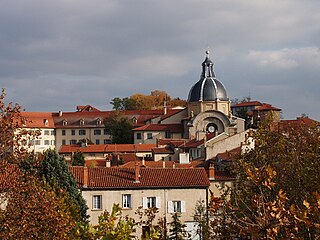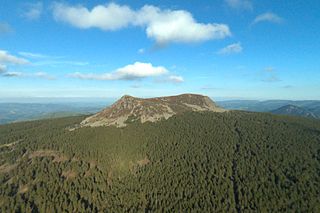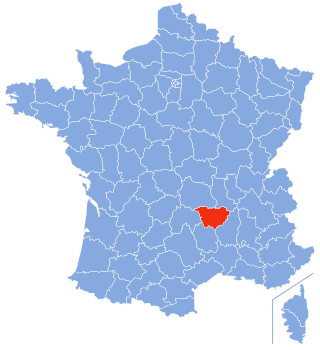
Loire is a landlocked département in the Auvergne-Rhône-Alpes region of France occupying the river Loire's upper reaches. Its prefecture is Saint-Étienne. It had a population of 765,634 in 2019.

Haute-Loire is a landlocked department in the Auvergne-Rhône-Alpes region of south-central France. Named after the Loire River, it is surrounded by the departments of Loire, Ardèche, Lozère, Cantal and Puy-de-Dôme. In 2019, it had a population of 227,570; its inhabitants are called Altiligériens in French.
Saint-Julien or St Julien is the French spelling for the English name "Julian." It may also refer to:
Le Puy or Puy may refer to the following municipalities in France:

Roquemaure is a small town and commune in the Gard department of southern France. The town lies 12 kilometres north of Avignon on the right bank of the Rhône. In 2017 the commune had a population of 5,481.

The arrondissement of Le Puy-en-Velay is an arrondissement of France in the Haute-Loire department in the Auvergne-Rhône-Alpes region. It has 102 communes. Its population is 96,498 (2016), and its area is 1,930.7 km2 (745.4 sq mi).
The following is a list of the 19 cantons of the Haute-Loire department, in France, following the French canton reorganisation which came into effect in March 2015:

Velay is a historical area of France situated in the east Haute-Loire département and southeast of Massif Central.

Saint-Sauveur-en-Rue is a commune in the Loire department in central France.

The Fort Saint-André is a medieval fortress in the commune of Villeneuve-lès-Avignon in the Gard département of France, dating from the first half of the 14th century.

Isabelle Valentin is a French politician of the Republicans who has been serving as a member of the National Assembly from 2017 to 2024, representing the 1st constituency of Haute-Loire.

The Château de Chalencon is a feudal monument situated in the hamlet of Chalencon, about 1 kilometre north east of the village of Saint-André-de-Chalencon, in the Haute-Loire département, in the Auvergne-Rhône-Alpes region of France.
Communauté d'agglomération du Puy-en-Velay is the communauté d'agglomération, an intercommunal structure, centred on the town of Le Puy-en-Velay. It is located in the Haute-Loire department, in the Auvergne-Rhône-Alpes region, south-central France. Created in 2017, its seat is in Le Puy-en-Velay. Its area is 1324.0 km2. Its population was 82,871 in 2019, of which 19,215 in Le Puy-en-Velay proper.

Auvergne is a former administrative region in central France, comprising the four departments of Allier, Puy-de-Dôme, Cantal and Haute-Loire. On 1 January 2016, the region was dissolved and its territory has been part of the new region Auvergne-Rhône-Alpes.
Jean Merley was a French historian and professor at the Université de Saint-Étienne, which he cofounded. He also founded the Centre de recherches historiques and became director of the Centre interdisciplinaire d'études et de recherche sur les structures régionales.

The Mont Mézenc is a mountain range in the Massif Central, bordering the departments of Ardèche and Haute-Loire, making up a natural region of France. Its highest point is Mount Mézenc, whose two summits, South and North, are respectively the highest in Ardèche at 1,753 meters and Haute-Loire at 1,744 meters.











